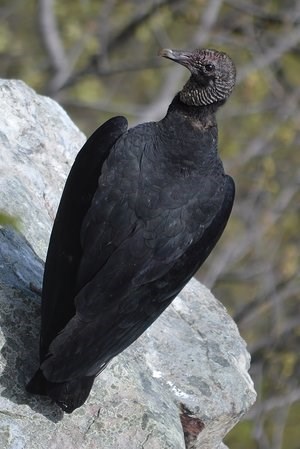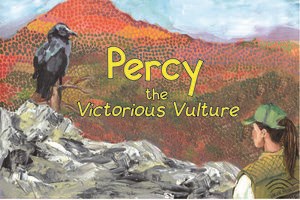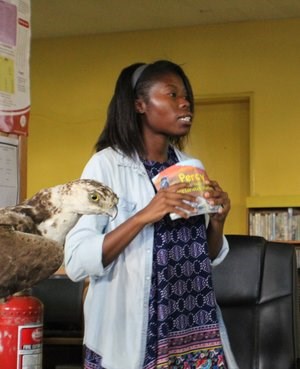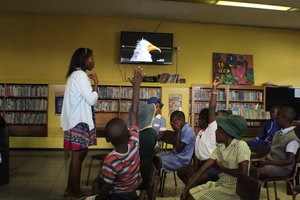Percy the Victorious Vulture: A Hit in Zimbabwe
Posted on in In the Field by Merlyn Nomusa Nkomo, Former Conservation Science Trainee

Vultures are generally not people’s favorite animal, especially with kids. They see them only in movies and story books that do no justice to the story of vultures, but only portray them as loathsome beasts. It cannot continue like this in our time; we cannot afford to let children go on being ignorant about issues of the state of their planet or the important role every organism plays in the ecosystem around them. If we let it happen, the world is going to be handed over to a more disastrous people than we have been, people that will not appreciate the life in it.
I personally did not think anything of vultures before my year-long internship at VulPro in South Africa. I did not love or hate them, but I knew they were not my preferred choice for birds to work with. I certainly thought I was going to be bored to death with them. My childhood had only just exposed me to the cute and grand side of wildlife: the lion prides filmed on television and the fluffy, little animals I would see at the wildlife orphanage from time to time. However, I always felt drawn to the weird animals, the strange ones that were not as easy to love, like painted wild dogs instead of cheetahs and lions. After seeing a lot of species of vultures, all affected by human actions, helplessly ceasing from poisonings, paralyzed from lead, and sometimes reduced to being flightless and confused from power line collisions, my passion for championing their cause was ignited. All birds should fly free, and it is up to us, the humans of today to make the right decisions to make it possible.

The children’s book Percy the Victorious Vulture was published in April 2017 while I was a trainee at Hawk Mountain. This book features the message of the importance of education birds and birds that are survivors of the hazards they face in the world today. The text in the book is very simple and precise, and it teaches kids about the importance of vultures, scientific techniques of tracking and trapping, monitoring, migration, and interactions of wildlife with humans in human-dominated landscapes.
With just this one small book, I am certain that Hawk Mountain Sanctuary has changed people’s perceptions on black vultures and vultures as a whole, and has opened a window through which readers can look into the everyday lives of the species.
I was very excited when I got my own copy of the book, as it gave me the idea of writing similar books on African raptors, since such education material is much needed in my region, and encouraged me to spread this story in my community. After talking to librarians in my city, they agreed to let me use their library space for education programs. This was wonderful, as the space is central for most people and is a hub for students and adults in the city. All the education and awareness work I had been doing before at the Natural History Museum had been a little exclusive because of time and location. A book reading was a perfect program to begin with, being at the library, and it justified my conservation education effort.

The turnout was amazing, kids with their parents and friends, and even some young adults who came to just ‘check it out’, all had never been to a book reading before, nevermind one about vultures. I myself had never been to a book reading and had no idea what happens at one other than reading it aloud to the audience. I was nervous, but eventually the day arrived, and kids filled the hall. Anybody that has presented in an educative capacity knows that kids are not the easiest crowd, and that they are sharp and can spring questions on you that take you back to the roots of a concept. It can be very intimidating. You also need to be entertaining and engaging, or else you’ll lose their attention, and they’ll be bored.
I talked to my friends at the museum, and they helped me put together my makeshift raptor education trunk. Unfortunately they had lost their vulture mount to an infection and only had a martial eagle and another raptor’s head that I could use. I put it in the box together with a cattle ear tag labelled 43 (Percy’s wing tag number) and made my way to the library. At the library, I set it up on a table and used the specimen mounts to define what raptors are and to compare adaptations of raptors to their different lifestyles, especially focusing on eagles and vultures which I had pictures of on a slideshow. Almost all of the kids in the room had never seen an eagle or vulture, and it was clearly exciting to be that close and able to touch them. The time came to read the book, and everyone was eagerly waiting to hear the story of Percy. To prevent stuttering and calm the nerves, I started off with introducing African vultures and their distribution using beautiful posters loaned to me by a friend, I know this information so well it is like telling a story I have told a thousand times but still get excited over; this made it easier to move on to the ‘book reading’ that I had no idea how to do.

I only had one copy of the book, and this presented the challenge of how to read and showcase the lovely illustrations while maintaining that excitement and enthusiasm readers must have with kids. Fortunately the kids were attentive and patient with me, and the contents of my raptor box kept them awake. At the end of the reading, I invited questions expecting a dozen questions to be fired my way but nothing came. I decided to then fire questions their way, and the response was amazing. These kids remembered all of the complex scientific terms I had read and explained plus some I had defined in passing. They seemed to have been absorbing everything I was reading. To be honest, just one question was asked, “Where can we buy or get copies of this book?” Unfortunately, I did not have the answer to this question.
This book reading I had planned to teach kids about vultures ended up teaching me a lot more. It reaffirmed the value of conservation education and awareness, especially at grass root level where perceptions are being sewn and grown in the minds of our future. I will endeavor this year to continue seeking opportunities to educate more youth and most importantly developing raptor education material for children in my region, for there is truly so much diversity in species, ecosystems, and cultures regarding raptor conservation. I’m afraid this counts as a publicized new year’s resolution!
